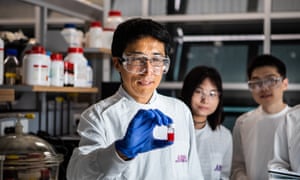
A flexible solar “skin” that could be used to generate power on homes, cars and phones is a step closer to development after the technology was used to break a world record for electricity conversion, researchers say.
Engineers at the University of Queensland have been working with nanoparticles known as quantum dots that pass electrons and generate an electrical current when exposed to solar energy.
The dots can be printed on flexible sheets that have the potential to be used as a transparent skin to power devices including mobile phones and electric vehicles, and applied to windows and other surfaces.
Lianzhou Wang, an Australian Research Council laureate fellow in materials engineering, and a team of researchers have broken the world record for the conversion of solar energy into electricity using these quantum dots.
The previous record efficiency for converting sunshine into electricity using quantum dot solar cells was 13.4%. The university said Wang and his team had increased that to 16.6%. It has been recognised as a record by the US National Energy Research Laboratory.
Wang said the improement of nearly 25% was a significant step towards the technology becoming commercially viable and supporting global efforts to cut carbon dioxide emissions.
“It is effectively the difference between quantum dot solar cell technology being an exciting prospect and being commercially viable,” he said.
Wang said advantages of the technology compared to traditional solar cell technology included it being lightweight, flexible and able to work in weaker light, such as on cloudy days or under indoor lighting. He said it could be used for a range of applications, including cars and wearable technology, and was relatively cheap to produce.
His team aims to increase the conversion efficiency to 20% and scale up the printing process to produce large solar cells.
“Our immediate target is to try to further break the world record in this category,” Wang said.
He said they hoped to develop a product that could be brought to market for small appliances, such as a phone, within two years, and within three to five years for large-scale power compatible with rooftop solar.
Simon Holmes à Court, a senior advisor to the Energy Transition Hub at the University of Melbourne, said the technology would have to be cheaper and have a smaller environmental footprint than existing solar options to be successful.
“There’s always a long list of reputed benefits for this kind of thing, but 99.9% of solar from here on goes either on people’s roofs or in fields in big solar farms,” he said.
The chief executive of the Smart Energy Council, John Grimes, said a lot of work had been done to try to come up with ways to make solar technology ubiquitous. He said traditional, silicon-based solar technologies were limited by being “fixed and brittle”.
“There’s a huge potential market for this type of application,” he said. “At 16.6% [efficiency], that’s really exciting. The solar most people have on their roof today is 19%.”
Grimes said existing silicon solar cells were already very cheap, making it a challenge for any new technology wanting to enter the market.
“It’s a question of getting the economics right. If they can do that it’s a fantastic development.”
We’re living up to our promise…
… to reduce the Guardian’s carbon footprint. In service of the escalating climate emergency, we have made an important decision – to renounce fossil fuel advertising, becoming the first major global news organisation to institute an outright ban on taking money from companies that extract fossil fuels.
The Guardian has pledged to give global heating, wildlife extinction and pollution the urgent attention and prominence they demand. That means changing the way we do our own business. In addition to turning down fossil fuel advertising, we’ve committed to becoming carbon-neutral by 2030 and divesting our Scott Trust endowment fund, which funds our journalism, from fossil fuel investment. The climate issue is the defining issue of our lifetime, and we realise the need to walk the talk in order to make a real difference.
You’ve read 216 articles in the last four months. We chose a different approach: to keep Guardian journalism open for all. We don’t have a paywall because we believe everyone deserves access to factual information, regardless of where they live or what they can afford to pay.
Our editorial independence means we are free to investigate and challenge inaction by those in power. We will inform our readers about threats to the environment based on scientific facts, not driven by commercial or political interests. And we have made several important changes to our style guide to ensure the language we use accurately reflects the environmental emergency.
The Guardian believes that the problems we face on the climate crisis are systemic and that fundamental societal change is needed. We will keep reporting on the efforts of individuals and communities around the world who are fearlessly taking a stand for future generations and the preservation of human life on earth. We want their stories to inspire hope.
We hope you will consider supporting us today. We need your support to keep delivering quality journalism that’s open and independent. Every reader contribution, however big or small, is so valuable.
[“source=theguardian”]




















